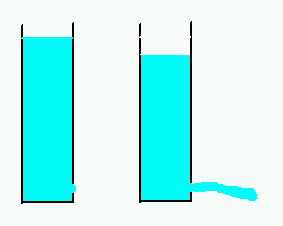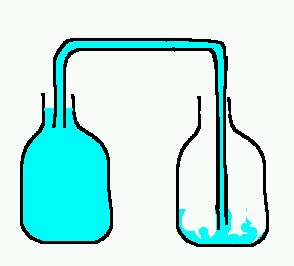 that are important to a fluid are kinetic energy (because it can move) and
gravitational energy (because it has weight). Water flowing downhill is
converting gravitational energy into kinetic energy.
that are important to a fluid are kinetic energy (because it can move) and
gravitational energy (because it has weight). Water flowing downhill is
converting gravitational energy into kinetic energy.
A fluid is a material that can flow, like water or air. The kinds of energy
 that are important to a fluid are kinetic energy (because it can move) and
gravitational energy (because it has weight). Water flowing downhill is
converting gravitational energy into kinetic energy.
that are important to a fluid are kinetic energy (because it can move) and
gravitational energy (because it has weight). Water flowing downhill is
converting gravitational energy into kinetic energy.
Flow rate is a characterization of how a fluid is moving. We need to distinguish clearly between flow rate and the velocity of the flowing fluid. The Mississippi river hardly seems to be moving as it goes by New Orleans -- certainly it is not very exciting -- but it is carrying all the water that went over Cumberland Falls in southern Kentucky (shown in the picture), and far more! The River at New Orleans is wider and deeper than the Cumberland River, and that is part of the flow rate, too.
The flow rate is determined by how fast the liquid is moving -- the speed of a leaf carried by the current -- and by how big the opening or pipe or river channel that the fluid is moving through. When we want to move a lot of liquid around, we need a large flow rate; this can be accomplished by having the liquid move very fast (think of the water racing out of the channel at the base of a dam) or by giving it a channel that is wide and deep. The Mississippi River carries 600,000 cubic feet of water past New Orleans every second; the river is 700 feet wide and 200 feet deep, so the water speed is only 5 feet per second. Every second, about 1000 cubic feet of water go over Cumberland Falls, but the falls are not very wide and the river is not very deep, so it is much more exciting.
Energy in fluids
As everyone knows, water flows downhill. This happens because its gravitational energy is changed into other forms -- sound, swirly motions in the water, and finally thermal energy (that can be detected as a tiny increase in temperature). The energy is now in many forms, and shared with everything nearby. Once the energy is shared this way, the water cannot regain it -- having moved down, it stays down.
 We can use the energy concept to explain why the surface of a pond is flat.
Suppose there was a pond whose surface was not flat. Then the "hill" of
water on one side can move into the "valley" on the other. This decreases
the gravitational energy, as just described. The surface is flat because
this gets the water as low as possible.
We can use the energy concept to explain why the surface of a pond is flat.
Suppose there was a pond whose surface was not flat. Then the "hill" of
water on one side can move into the "valley" on the other. This decreases
the gravitational energy, as just described. The surface is flat because
this gets the water as low as possible.
Energy considerations also explain how fast water runs out of a
container.
 Consider a tall tank of water, and suppose we remove a small
amount -- let us say 1 liter (a mass of 1 Kg) -- by an outlet at
the bottom. Even though we removed
the water at the bottom, there is not an empty space there --
water moved in from surrounding regions to fill it up. The volume of
liquid in the tank is smaller by 1 liter, but to show this we have to
look at the water level at the top of the tank, which is now slightly lower.
The water that we removed seems to have come from the top of the tank,
even though it came out at the bottom. Another way to accomplish the same
thing would be to have the water flow out through an outlet near the top,
and then fall to the bottom. The change in the gravitational energy is
the same (because it depends only on how much water is where, and not
on how it got there), and so
the resulting kinetic energy of the water is the same, too.
Consider a tall tank of water, and suppose we remove a small
amount -- let us say 1 liter (a mass of 1 Kg) -- by an outlet at
the bottom. Even though we removed
the water at the bottom, there is not an empty space there --
water moved in from surrounding regions to fill it up. The volume of
liquid in the tank is smaller by 1 liter, but to show this we have to
look at the water level at the top of the tank, which is now slightly lower.
The water that we removed seems to have come from the top of the tank,
even though it came out at the bottom. Another way to accomplish the same
thing would be to have the water flow out through an outlet near the top,
and then fall to the bottom. The change in the gravitational energy is
the same (because it depends only on how much water is where, and not
on how it got there), and so
the resulting kinetic energy of the water is the same, too.

Here is a picture of a container with several holes at different heights. You can see that the water is coming out faster at the bottom. It has more kinetic energy than the water running out higher.
Another way to describe this effect is in terms of the concept of pressure. The pressure is higher at the bottom of the container, which pushes the water out faster. These two explanations sound different but actually are not: although pressure is usually stated in terms of force per unit area (pounds per square inch, for example), it determines how much the energy of the system will decrease when a unit volume of fluid leaves, and could be stated as energy per unit volume. It is the energy that is turned into kinetic energy when a volume of water leaves the tank. This energy is higher for water at the bottom of the tank because all the water above the hole gets to move down a little bit.
Water pressure increases as we descend into a tank of water. This can be explained in two equivalent ways:
Usually water will not flow uphill spontaneously, and so it seems
surprising that a siphon works. However, each observation can be explained
in terms of the energy of the system.
 For water to move upwards, energy must
be supplied. Connecting two containers by an air-filled tube will
not cause anything to happen, since there is no source of energy to move the
water up into the tube.
For water to move upwards, energy must
be supplied. Connecting two containers by an air-filled tube will
not cause anything to happen, since there is no source of energy to move the
water up into the tube.
 But
when the tube is already full of water, flow can happen, because the energy needed
to lift the first tube-full of water has already been invested. After that,
the total gravitational energy of the water in the tube doesn't change: as water
moves up on one side, water moves down on the other. As the fluid flows,
water flows from the container with the higher surface level to the container
with the lower surface level, and the
net effect on the whole system is that the gravitational energy is decreasing.
But
when the tube is already full of water, flow can happen, because the energy needed
to lift the first tube-full of water has already been invested. After that,
the total gravitational energy of the water in the tube doesn't change: as water
moves up on one side, water moves down on the other. As the fluid flows,
water flows from the container with the higher surface level to the container
with the lower surface level, and the
net effect on the whole system is that the gravitational energy is decreasing.
The larger is the height difference between
the two liquid levels connected by the siphon, the larger is the flow rate in the
tube for a given tube. A wider tube will allow a higher flow rate,
and a longer tube will have a lower flow rate.
Check the box when you are done:
Next:Discussion of fluids